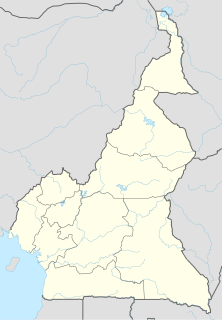Related Research Articles

Southern Bantoid is a branch of the Bantoid language family. It consists of the Bantu languages along with several small branches and isolates of eastern Nigeria and west-central Cameroon. Since the Bantu languages are spoken across most of Sub-Saharan Africa, Southern Bantoid comprises 643 languages as counted by Ethnologue, though many of these are mutually intelligible.

Oshie is a small mountainous village covering approximately 70 square kilometers. It is located in the English-speaking Northwest Province of Cameroon. It is located to the east of Njikwa Sub-division in Momo Division and forms a geographical gate way into Njikwa. Oshie is a land of rich physical diversity and presents an undulating landscape which is an extension of the Bamboutos Highlands of the Western Highlands of Cameroon. It is a centre of Garri production.
The Kassonke (Khassonké) language, Xaasongaxango (Xasonga), or Western Maninka (Malinke), is a Manding language spoken by the Khassonké and Malinke of western Mali and by the Malinke of eastern Senegal. Kassonke is a national language in Mali. Western and Eastern Maninka are 90% mutually intelligible, though distinct from the Mandinka (Malinke) of southern Senegal, which is a national language there.

The Beboid languages are any of several groups of languages spoken principally in southwest Cameroon, although two languages are spoken over the border in Nigeria. They are probably not most closely related to each other. The Eastern Beboid languages may be most closely related to the Tivoid and Momo groups, though some of the geographical Western Beboid grouping may be closer to Ekoid and Bantu.

The Grassfields languages are a branch of Southern Bantoid spoken in the Western High Plateau of Cameroon and some parts of Taraba state, Nigeria. Better known Grassfields languages include the Eastern Grassfields languages Bamun, Yamba and the Ring language Kom. The languages are closely related, sharing approximately half of their vocabulary.
Kemezung is a Southern Bantoid language of Cameroon. According to Ethnologue, it's 85% lexically similar to Bebe.
Fuliiru is a Great Lakes Bantu language spoken by the Fuliiru people (Bafuliiru), also known as the Fuliru or Fulero, who live north and west of the town of Uvira in Uvira Territory, South Kivu province in the far eastern part of the Democratic Republic of the Congo. It is closely related to Kinyindu.

Misaje is a town and commune in Donga-Mantung department in the Northwest Region of Cameroon. The town lies at the top of the Ring Road, about 15 kilometers west of Nkambé, where the Ring Road meets the road north to Dumbu and the border with Nigeria.
The Noni language, also called Noone, is an Eastern Beboid language of the Niger–Congo family in Cameroon. The Noone, Ncane, and Mungong varieties are sometimes considered three distinct Noni languages. Ethnologue reports that Ncare is 88% lexically similar with Noone, and 84% with Saari (Nsari).
Fipa is a Bantu language of Tanzania. It is spoken by the Fipa people, who live on the Ufipa plateau in the Rukwa Region of South West Tanzania between Lake Tanganyika and Lake Rukwa. The ethnic group of the Fipa people is larger than the group of Fipa language speakers. On the Tanzanian side, people who speak Mambwe-Lungu may identify as Fipa and consider their language to be a dialect of Fipa. Lungu and Mambwe are also spoken in Zambia where they are considered languages and their speakers are considered to be ethnic groups in their own right, although linguists consider Lungu and Mambwe to be dialects of a single language. There are three dialects: Milanzi, Kwa (Ichikwa) and Nkansi.
Naki, or Munkaf, is an Eastern Beboid language of Cameroon and Nigeria. There is no name for the language; it is known by the villages it is spoken in, including Naki and Mekaf (Munkaf) in Cameroon and Bukwen and Mashi in Nigeria, the latter listed as separate languages by Ethnologue, though they are not distinct.
Fang is a Southern Bantoid language of Cameroon.
Koshin is a Southern Bantoid language of Cameroon. It is traditionally classified as a Western Beboid language, but that has not been demonstrated to be a valid family.
Mundabli is a Southern Bantoid language of Cameroon. It is traditionally classified as a Western Beboid language, but that has not been demonstrated to be a valid family.
Mbuʼ, or Ajumbu, is a Southern Bantoid language of Cameroon. It is traditionally classified as a Western Beboid language, but that has not been demonstrated to be a valid family. Inasmuch as Western Beboid may be valid, Mbuʼ would appear to be the most divergent of its languages.
Saari, or Nsari, is an Eastern Beboid language of Cameroon. According to Ethnologue, it's 84% lexically similar to Ncane, making it very close to the Noni cluster.
Chung (Cung) is an Eastern Beboid language of Cameroon.
Babanki, or Kejom (Kidzem), is a Grassfields Bantu language spoken in northwestern Cameroon. Babanki is spoken primarily in the communities of Big Babanki and Babanki Tungo, and approximately 39,000 people belonging to the Babanki community.
Swo is a Bantu language of the Akonolinga area, Cameroon. Spellings of the name are quite variable, including So, Sso, Shwo, and Fo. One dialect has been influenced by Beti.
Ngurimi (Ngoreme) is a Bantu language of Tanzania. Ngoreme is spoken in the Serengeti District of the Mara Region of north-west Tanzania by some 55, 000 people. There are two main dialects of Ngoreme - a northern dialect and a southern dialect - which maintain mutual intelligibility.
References
- ↑ Bebe at Ethnologue (18th ed., 2015) (subscription required)
- Blench, Roger, 2011. 'The membership and internal structure of Bantoid and the border with Bantu'. Bantu IV, Humboldt University, Berlin.
- Brye, Edward and Elizabeth Brye. 2004. "Intelligibility testing survey of Bebe and Kemezung and synthesis of sociolinguistic research of the Eastern Beboid cluster." SIL Electronic Survey Reports 2004-011: 18 p. http://www.sil.org/silesr/abstract.asp?ref=2004-011